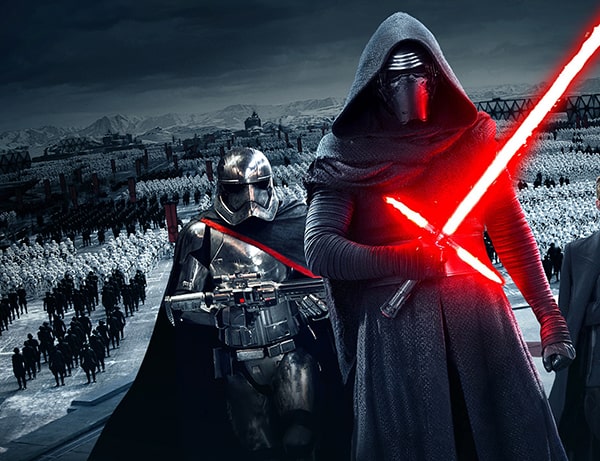
Above: Kylo Ren and his spitty lightsabre are key to understanding The Force Awakens. Deeply conflicted and confused, he looks good, but is capable of destroying anything he doesn’t control or understand.
BitDepth#1021 for December 29, 2015
Last week I spent two hours and fifteen minutes in a local cinema in a state of deep conflict.
On the screen was Star Wars: The Force Awakens (TFA), a film that every fan of the franchise hoped to see one day, a bold and confident return to the cinematic glory that George Lucas delivered in May 1977.
The new film is an exciting adventure, full of the sequel gracenotes that make returning to a franchise so much fun for regular viewers but structured with the modern pacing and mood that a first time audience expects.
The question really, is whether TFA – despite offering up a universe that looks one hell of a lot like one that’s supposed to be far, far away – is still the Star Wars that Lucas imagined.
Despite that glittering gold Lucasfilm logo that opens the movie, this is no longer something that George Lucas owns or has any active part in anymore.
It is now that interesting financial entity beloved of accountants and managers, a “property,” and one that’s destined to be thoroughly mined and exploited.
The early success of TFA suggests that the US$4 billion that Disney paid Lucas is beginning to look like the apocryphal purchase of America for a handful of beads.
It’s also interesting that TFA opens just as the trailer for the new Star Trek film appeared in cinemas. Under the direction of Fast and Furious wonderboy Justin Lin, it immediately sparked concerns that the film was going to embrace hip briskness and diminish the meditative contemplation that classic Trek was built on.
Both franchises have at least one thing in common, despite the long standing antipathy between Trek and Wars fans.
Both are large, detailed universes brought fully into existence by a single overseeing mind, in the case of Star Trek, the iron-fisted and sometimes ham-handed approach of Gene Roddenberry.
Both men quickly earned a reputation as troublesome in their respective industries, Roddenberry in television and Lucas in film with their creations.
You can add to that list of problem creators J. Michael Straczynski’s Babylon 5 and pretty much anything by Alan Moore.
George Lucas had a better time of it, if only because nobody understood what he was up to with Star Wars and the industry diffidence to the film allowed him to retain ownership of Star Wars for 36 years until he chose to sell it to Disney.
Difficult and troublesome are, of course, just business shorthand for not playing by established rules and failing to crave the greatest return on investment.
Lucas might legitimately be accused of poor creative judgement in some of his decisions in the films he made and produced, beginning with the almost nuclear creative disaster (and revenue generating success) that were the Ewoks, the deadly aboriginal teddybears of Return of the Jedi.
It was a toy-focused error he would make 16 years later in his return to filmmaking with the excrecable and tone-deaf Jar Jar Binks and Trade Federation of The Phantom Menace.
And yet, even in the midst of all these impenetrably stupid decisions, there was a glimpse into the singular mind of the man creating them, a film buff who raided the catalog of cinema and popular literature he’d grown up with for inspiration, taking Han Solo from western gunfighters, designing Luke Skywalker as a youthful and inexperienced Flash Gordon and to his credit, giving his Princess Leia the brain she would have noticeably lacked in 1930’s cardboard set SciFi serials.
So Jar Jar Binks became an Amos and Andy buffoon and the merchants of the Trade Federation took their villainous cues equally from shopkeepers and Fu Manchu.
These would prove to be problems for Lucas’ audience in much the same way that his decision to let Star Wars lie fallow for a decade and a half would have irritated a film industry keen to have those long lines around the block.
I’ve been watching the first six films again and with the distance of time and the armor to resist their worst moments, they actually are quite remarkable films, even the prequels, which it’s become fashionable to dismiss.
It’s true that all three prequels could have been one very long film or two more detailed prequels, but they are full of things that only Lucas could imagine.
Where TFA looks to Star Wars itself for guidance, the franchise creator could decide to set aside the time to rather arbitrarily remake the chariot race from Ben Hur.
By contrast, JJ Abrams finally fires the big gun on a planet killer starship and destroys five or six planets to some political end which the film makes no effort to explain or contextualise.
Beyond that, TFA (and the upcoming Star Trek Beyond), make energetic use of modern action adventure tropes, including heroes running from gunfire which closely tracks their footsteps and the leap to the camera from a screen-filling orange ball of explosive flame.
These techniques are not hallmarks of filmed contemplative science fiction and haven’t been part of either the Trek or Wars universes. Until now.
Which begs the question who does Star Wars belong to now?
Is it the fans, whose needs are handsomely met with TFA?
Is it the creators who will each add their craft to new installments?
Or is it Disney, which owns the property, but needs creative teams and an audience to make sense of its investment?
One thing’s for sure, it isn’t the Star Wars of George Lucas, and while few will shed a tear for that, it’s a special kind of loss on it’s own, a lightsabre to the heart of something that was, for three and a half decades, one man’s singular vision with all the problems that entails.


